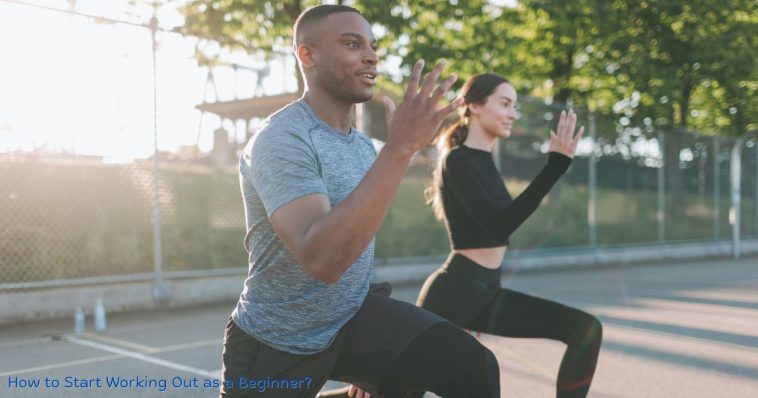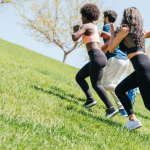Thinking about starting a workout routine but not sure where to begin? You’re not alone, because Working out as a beginner can feel intimidating to anyone—between the overwhelming options, fitness jargon, and fear of doing something wrong, it’s easy to feel lost. But here’s the good news: working out doesn’t have to be complicated. Whether your goal is to get healthier, lose weight, or simply move more, you can build a strong foundation by focusing on the basics.
This guide will walk you through everything you need to know about starting a workout routine as a beginner. From creating a simple yet effective workout plan to understanding how long you should exercise and what to eat before your session, we’ll break it down step by step. So, lace up your sneakers, take a deep breath, and let’s dive into the world of fitness with confidence.
Why Exercise Matters: The Benefits of Moving More
Before we get into the how-to, let’s quickly explore why working out matters. Exercise isn’t just about looking fit—it’s about feeling good. Here are some science-backed benefits that come with starting a workout routine:
- Boosts mood and reduces stress: Physical activity releases endorphins, which help improve your mood and reduce stress.
- Improves energy levels: Regular exercise helps your body produce more energy, leaving you feeling less tired.
- Supports weight management: Whether you want to lose weight or maintain it, exercise plays a key role.
- Strengthens muscles and bones: Resistance exercises like weightlifting or bodyweight moves help build muscle and bone strength.
- Improves heart health: Cardiovascular exercises like walking, jogging, or cycling improve your heart health and circulation.
How to Start Working Out as a Beginner
Starting a workout for the first time can feel overwhelming, but breaking it down into manageable steps makes it easier. Here’s how you can start working out as a beginner with confidence and clarity:
1. Set Realistic Goals
Having clear goals keeps you motivated. Ask yourself what you want to achieve—whether it’s losing weight, gaining strength, improving flexibility, or just moving more. Avoid vague goals like “I want to get fit.” Instead, try specific goals such as:
- “I want to exercise three times a week for 30 minutes.”
- “I want to be able to do 10 push-ups by the end of the month.”
Setting short-term, measurable goals makes it easier to see progress and stay motivated. As you achieve these milestones, you’ll naturally build confidence and be inspired to aim higher.
2. Choose the Right Type of Exercise
Not all exercises are created equal, and finding the right one can make a big difference in your enjoyment. Here are a few beginner-friendly options:
- Walking: A great low-impact cardio option. Aim for brisk walking for 20–30 minutes.
- Bodyweight Exercises: Simple moves like squats, lunges, and push-ups don’t require equipment.
- Yoga or Stretching: Ideal for improving flexibility and reducing stress.
- Swimming or Cycling: Excellent for low-impact cardio if you prefer non-weight-bearing activities.
Choose something that feels enjoyable rather than daunting. The more fun your workout is, the more likely you are to stick with it.
3. Focus on Consistency, Not Perfection
The key to success is consistency, not how hard you work out on day one. Start with small, manageable sessions—such as 20 minutes three times a week. As your body adapts, you can increase the frequency, intensity, and duration. Don’t worry if you miss a workout—just focus on getting back on track the next day.
4. Prioritize Warm-Ups and Cool-Downs
Warming up and cooling down are essential to prevent injury and aid recovery:
- Warm-up: Spend 5–10 minutes doing dynamic stretches or light cardio, like marching in place or arm circles, to get your blood flowing.
- Cool-down: After your workout, do gentle stretching to help relax your muscles and reduce soreness.
These steps may seem small, but they’re vital in making your workout more effective and comfortable.
5. Learn Proper Form to Prevent Injury
Good form is critical, especially when you’re starting out. Poor technique can lead to injuries, which could derail your progress. Here’s how to ensure proper form:
- Mirror Check: Use a mirror to monitor your posture and alignment during exercises.
- Guided Videos: Follow beginner-friendly workout videos from certified trainers.
- Ask for Help: If possible, invest in a session or two with a personal trainer to learn the basics.
6. Schedule Your Workouts Like Appointments
Treat your workout like any other important appointment. Block out time in your calendar and stick to it. This builds a routine, making it easier to develop the habit.
7. Listen to Your Body
It’s important to push yourself, but not to the point of pain or injury. Pay attention to how your body feels:
- Good Soreness: Feeling sore in your muscles is normal and a sign that you’re challenging yourself.
- Bad Pain: Sharp or intense pain is a warning sign. Stop immediately and rest or seek medical advice if needed.
A Simple Workout Plan for Beginners
Starting with a balanced workout plan helps you build strength, endurance, and flexibility without overwhelming your body. Below is a simple, effective weekly plan that targets different areas of fitness: strength training, cardio, and active recovery. This plan is perfect for beginners who want to ease into exercise while building a solid foundation.
Day 1: Full-Body Strength Training (20-30 minutes)
Strength training is essential for building muscle, boosting metabolism, and improving overall strength. Focus on bodyweight exercises that are easy to modify as you progress.
- Bodyweight Squats (3 sets of 10-12 reps)
- Stand with feet shoulder-width apart.
- Lower your hips back and down as if sitting in a chair.
- Keep your chest lifted and knees behind your toes.
- Press through your heels to return to standing.
- Modified Push-ups (3 sets of 8-10 reps)
- Start on your knees with hands slightly wider than shoulder-width.
- Lower your chest toward the floor while keeping your body in a straight line.
- Push back up to the starting position.
- Plank Hold (3 sets of 20-30 seconds)
- Get into a forearm plank position with your body in a straight line from head to heels.
- Engage your core and hold, keeping your back flat.
- Lunges (3 sets of 10 reps per leg)
- Step forward with one foot, lowering your body until both knees form 90-degree angles.
- Push back to the starting position and switch legs.
Day 2: Active Recovery or Light Activity (20-30 minutes)
Active recovery helps reduce muscle soreness and promotes blood flow without intense effort. Try activities such as:
- Brisk walking
- Gentle yoga or stretching
- Casual bike ride
Day 3: Cardio Session (20-30 minutes)
Cardio boosts heart health, burns calories, and improves endurance. Choose moderate-intensity activities that raise your heart rate but allow you to carry on a conversation.
- Brisk Walking or Jogging
- Walk at a fast pace or alternate between walking and jogging for 20-30 minutes.
- Jumping Jacks (3 sets of 30 seconds)
- Jump feet wide while raising arms overhead. Return to the starting position and repeat.
- High Knees (3 sets of 20 seconds)
- Jog in place, bringing your knees as high as possible, pumping your arms as you go.
Day 4: Rest or Light Stretching
Rest is essential for recovery and muscle growth. If you feel like moving, stick to light activities:
- Foam rolling
- Gentle stretching
- Meditation or breathing exercises
Day 5: Full-Body Strength Training (Repeat Day 1)
Revisit the same strength training routine from Day 1. Focus on maintaining proper form and gradually increasing repetitions as you get stronger.
Day 6: Cardio Session (Repeat Day 3)
Repeat the cardio routine from Day 3. If you’re feeling more confident, try increasing the intensity by jogging longer or adding a minute or two to each set of exercises.
Day 7: Rest or Active Recovery
Take a full rest day or engage in light activity similar to Day 2. This day helps your body recover and prevents burnout.
Progression Tips for Beginners
- Start Slow and Steady: Gradually increase repetitions, duration, or intensity as you feel comfortable.
- Track Your Workouts: Keep a log to note your reps, sets, and how you feel after each session.
- Listen to Your Body: If you feel fatigued or sore, take an extra rest day or reduce intensity.
- Incorporate Variety: As you progress, try adding resistance bands or light weights to your strength routine.
- As a beginner, start with 20-30 minutes per session, three to four times a week. Over time, as you build endurance, aim to increase the duration and intensity gradually. Listening to your body is key—if you feel fatigued or sore, give yourself extra rest.
What to Eat Before Working Out
Eating the right food before a workout can make a big difference in your energy levels and performance. Here’s what to focus on:
1. Carbohydrates for Energy
Carbs are your body’s primary source of energy. Good pre-workout options include:
- A banana with a small handful of almonds
- Oatmeal with berries
- Whole-grain toast with peanut butter
2. Protein for Muscle Support
Protein helps repair and build muscles. Combine it with carbs for a balanced snack:
- Greek yogurt with a drizzle of honey
- A smoothie with protein powder and fruit
- Hard-boiled eggs with a slice of whole-grain bread
3. Timing Matters
Eat 1 to 2 hours before your workout to avoid discomfort during exercise. If you’re short on time, opt for a light snack like a banana 30 minutes before starting.
Tips for Staying Motivated as a Beginner
Staying motivated when you’re just starting your workout journey can be challenging, but it’s not impossible. Motivation can dip from time to time, so it’s important to have strategies that keep you engaged and committed to your goals. Here are some practical tips to help you stay on track:
1. Set Short-Term Milestones
Long-term goals like losing 20 pounds or running a marathon can feel daunting, especially when progress is slow. Instead, set smaller milestones that are easier to achieve and celebrate. For example:
- “Complete three workouts this week.”
- “Hold a plank for 30 seconds without stopping.”
- “Increase my walk from 15 minutes to 20 minutes.”
Each small success boosts your confidence and builds momentum. Over time, these small wins accumulate into significant progress.
2. Create a Reward System
Rewarding yourself for sticking to your workout routine can be a powerful motivator. Make sure the rewards align with your goals and are something you look forward to. For example:
- Non-food rewards: Buy new workout gear, treat yourself to a massage, or watch an extra episode of your favorite show.
- Milestone rewards: After completing a month of consistent workouts, consider a bigger reward like a weekend getaway or a new gadget.
Rewards give you something tangible to work toward and make the process more enjoyable.
3. Find a Workout Buddy
Exercising with a friend or family member can make workouts more enjoyable and keep you accountable. When you know someone else is counting on you, you’re less likely to skip a session. If you don’t have an in-person workout buddy, consider joining online fitness communities or virtual workout classes.
4. Switch Up Your Routine
Doing the same workout every day can get boring, leading to a loss of motivation. Keep things fresh by trying new activities, such as:
- Yoga, Pilates, or dance classes.
- Hiking, swimming, or cycling.
- Strength training with resistance bands or dumbbells.
Variety not only keeps things interesting but also challenges your body in new ways, helping you avoid plateaus.
5. Use Music or Podcasts for Motivation
Create a high-energy workout playlist with songs that pump you up. Alternatively, listen to an interesting podcast or audiobook to keep your mind engaged while exercising. Music can boost your mood and energy, while podcasts can make the time fly by.
6. Track Your Progress Visually
Keeping a visual record of your progress can be incredibly motivating. Use a fitness app, journal, or calendar to track:
- The number of workouts completed.
- Improvements in strength, endurance, or flexibility.
- Changes in how you feel—more energetic, less stressed, etc.
Seeing your progress laid out visually can remind you of how far you’ve come, even on days when you feel like skipping a workout.
7. Focus on How You Feel, Not Just Results
Many beginners quit because they focus solely on physical results, like weight loss, which can take time to show. Instead, pay attention to non-scale victories such as:
- Increased energy levels.
- Better sleep quality.
- Feeling less stressed and more confident.
When you focus on how exercise makes you feel, you’re more likely to stay motivated, even if the physical changes take longer to appear.
8. Make It a Habit
Motivation may fade, but habits stick. Aim to work out at the same time each day to create a routine. Over time, it will feel as natural as brushing your teeth. Consistency, even with short sessions, is more important than perfection.
9. Be Kind to Yourself
Not every workout will be perfect, and that’s okay. Avoid negative self-talk and remember that progress is not linear. If you miss a workout or have an off day, don’t give up. Simply get back on track the next day and remind yourself that consistency over time matters most.
10. Visualize Your Success
Spend a few minutes each day visualizing yourself achieving your goals. Picture yourself feeling strong, energetic, and confident. Visualization can help reinforce your commitment and keep you focused on the positive outcomes.
Bonus Tip: Seek Inspiration from Others
Follow fitness influencers, join online fitness groups, or read success stories to stay inspired. Seeing others’ journeys can remind you that progress takes time, and it’s possible for you too.
Conclusion
Starting a workout routine as a beginner can feel daunting, but it doesn’t have to be. By setting realistic goals, starting small, and focusing on consistency over perfection, you’ll build a strong foundation for a healthier lifestyle. Remember, the best workout is the one you enjoy and stick with.
Don’t forget that progress takes time. Be patient, listen to your body, and celebrate every step forward. The key is to focus on building a habit that becomes a sustainable part of your life. Now, take that first step, and enjoy the journey toward a healthier, happier you.



